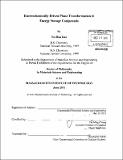Electrochemically driven phase transformation in energy storage compounds
Author(s)
Gao, Yuhua
DownloadFull printable version (15.67Mb)
Other Contributors
Massachusetts Institute of Technology. Dept. of Materials Science and Engineering.
Advisor
Yet-Ming Chiang.
Terms of use
Metadata
Show full item recordAbstract
Nanoscale lithium transition metal phosphate olivines have become commercially important as positive electrode materials in a new generation of lithium-ion batteries. Not surprisingly, many energy storage compounds undergo phase transitions in-situ, including the production of metastable phases. Unique to this environment is the frequent application of electrical over- and underpotentials, which are the electrical analogs to undercooling and superheating. So far, overpotential effects on phase stability and transformation mechanisms have not been studied in detail. Here we use synchrotron X-ray diffraction performed in-situ during potentiostatic and galvanostatic cycling, combined with phase-field modeling, to reveal a remarkable dependence of phase transition pathways on overpotential in the model olivine Lii. ,FePO 4. For a sample of particle size -113 nm, at both low (e.g., <20 mV) and high (e.g., >75 mV) overpotentials, a crystal-to-crystal olivine transformation is preferred, whereas at intermediate overpotentials a crystalline-to-amorphous phase transition dominates. As particle sizes decrease to the nanoscale, amorphization is further emphasized. Moreover, in the LiipxFei. yMnyPO 4 (y=0. 1, 0.4) system, the phase transition behavior is ovepotential dependent, and the crystallization of the amorphous phase is overpotential driven. An extensive nonequilibrium solid solution has been observed upon galvanostatic discharge. The misfit strain between two end members determines the reaction type as well as the phase transformation rate. High rate capability is expected in Lii.xFe1.yMnyPO 4 when the misfit is adequately tuned by Mn content. In addition, the discrepancy in phase compositions between dynamic and equilibrium states can be resolved by inter-crystallite ion diffusion among phases, e.g. ion diffusion between amorphous and crystalline phases.
Description
Thesis (Ph. D.)--Massachusetts Institute of Technology, Dept. of Materials Science and Engineering, 2011. Cataloged from PDF version of thesis. Includes bibliographical references (p. 124-132).
Date issued
2011Department
Massachusetts Institute of Technology. Department of Materials Science and EngineeringPublisher
Massachusetts Institute of Technology
Keywords
Materials Science and Engineering.